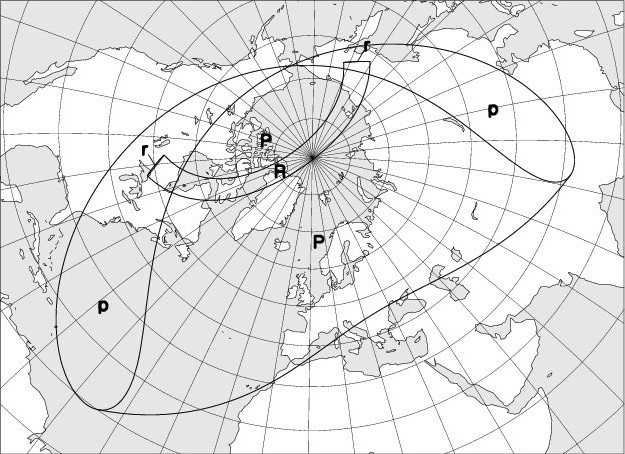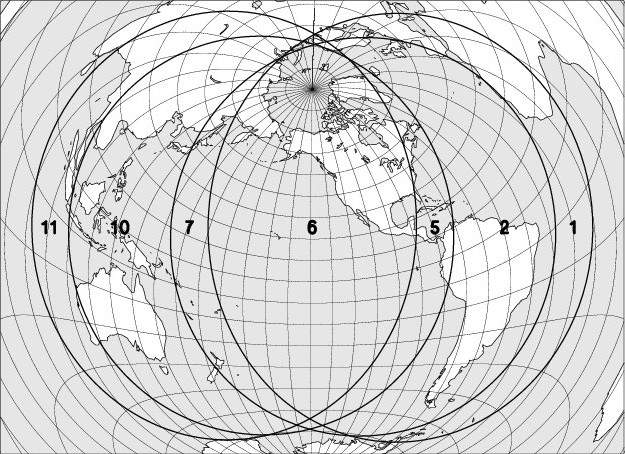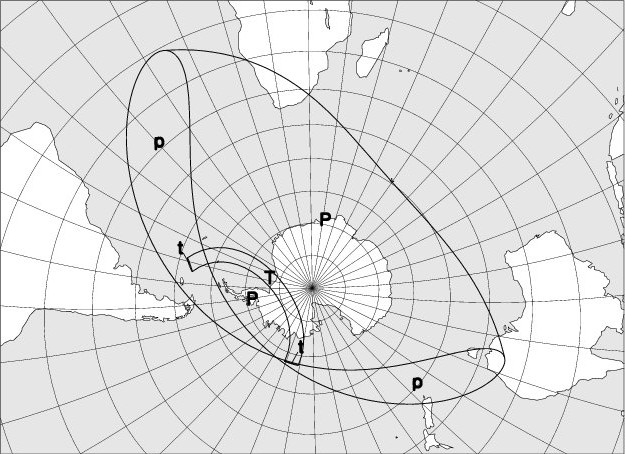In 2021, there will be four eclipses: two solar eclipses and two lunar eclipses
| Date | Type | Visibility |
| 26 May 2021 | Total lunar eclipse | Not visible in Belgium |
| 10 June 2021 | Annular solar eclipse | Visible in Belgium as a partial eclipse |
| 19 November 2021 | Partial lunar eclipse | Partially visible in Belgium |
| 4 December 2021 | Total solar eclipse | Not visible in Belgium |
I – 26 May 2021 – Total lunar eclipse, not visible in Belgium
| Phase | Universal Time | Longitude | Latitude | Position angle | Altitude at Uccle/Ukkel |
| Penumbral eclipse begins | 08h46.2 | 133 41 W | 20 18 S | 124 E | – |
| Partial lunar eclipse begins | 09h44.6 | 147 42 W | 20 28 S | 133 E | – |
| Total lunar eclipse begins | 11h09.4 | 168 03 W | 20 43 S | 185 E | – |
| Maximum de l’éclipse | 11h18.7 | 170 16 W | 20 44 S | 196 E | – |
| Total lunar eclipse ends | 11h27.9 | 172 29 W | 20 46 S | 206 E | – |
| Partial lunar eclipse ends | 12h52.8 | 167 11 E | 21 00 S | 258 E | – |
| Penumbral eclipse ends | 13h51.2 | 153 10 E | 21 10 S | 268 E | – |
The longitude and the latitude refer to the point on Earth where the Moon is at that time at its zenith. The position angle is defined from the imaginary line that connects the center of the lunar disc to the center of the Earth’s shadow. It is measured at the center of the lunar disc, from the North, in an anti-clockwise direction. At the beginning and at the end of the penumbra and shadow phases, it is the position angle of the contact point. The altitude and times of the Moon’s rise and fall are calculated for its center, without taking refraction into account.
Magnitude of the eclipse: 1.015, the diameter of the solar disk being taken as the unit.
The map below shows the region where the eclipse is observable. The explanation of the codes used can be found at the bottom of the page.

II – 10 June 2021 – Annular solar eclipse, visible in Belgium as a partial solar eclipse
| Phase | Universal Time | Longitude | Latitude |
| Eclipse begins | 08h12.3 | 044 10 W | 23 29 N |
| Annular eclipse begins | 09h49.8 | 086 29 W | 48 13 N |
| Central eclipse begins | 09h54.9 | 089 30 W | 50 10 N |
| Maximum of the eclipse | 10h42.8 | 066 57 W | 81 16 N |
| Central eclipse at the local solar noon | 11h01.1 | 165 23 W | 88 09 N |
| Central eclipse ends | 11h28.7 | 156 32 E | 63 34 N |
| Annular eclipse ends | 11h33.8 | 151 19 E | 62 13 N |
| Eclipse ends | 13h11.4 | 094 22 E | 41 16 N |
Magnitude of the eclipse: 0.944, the diameter of the solar disk being taken as the unit.
The map below shows the region where the eclipse is observable. The explanation of the codes used can be found at the bottom of the page.

The duration of the annular phase along the centrality line will reach a maximum of 3m 48s at a point located at 67° of longitude west and 81° of latitude north.
Phases in Uccle/Ukkel – Brussels (Observatory)
| Phase | Universal Time | Position angle relative to the pole |
Position angle relative to the zenith | Altitude at Uccle/Ukkel |
| First contact | 09h17min01s | 298 | 334 | +51 |
| Maximum of the eclipse | 10h19min06s | 342 | 007 | +58 |
| Last contact | 11h25min09s | 026 | 032 | +62 |
Magnitude of the eclipse: 0.263, the diameter of the solar disk being taken as the unit.
The position angle relative to the pole, resp. the zenith, is the angle formed by the direction of the centre of the lunar disc with the direction of the pole, resp. the zenith. Both angles are measured at the centre of the solar disc in an anti-clockwise direction. At the beginning and at the end of the eclipse, they correspond to the position angles of the contact points.
The altitude of the Sun is that of a reference point, which is located during the eclipse in the eclipsed part of the Sun, and which coincides with the times of contact with the point of contact of the Sun and Moon. Refraction is not taken into account.
Visibility in Belgium
The table below gives the phases for some representative Belgian sites.
In Brussels and Wallonia:
| Location | Begin in universal time | Maximum in universal time | End in universal time | Magnitude |
| Brussels | 09h17min01s | 10h19min11s | 11h25min20s | 0.265 |
| Nivelles/Nijvel | 09h16min56s | 10h18min40s | 11h24min22s | 0.259 |
| Jodoigne/Geldenaken | 09h18min05s | 10h19min51s | 11h25min28s | 0.258 |
| Tournai/Doornik | 09h15min01s | 10h17min05s | 11h23min18s | 0.267 |
| Mons/Bergen | 09h16min09s | 10h17min45s | 11h23min49s | 0.259 |
| Charleroi | 09h17min12s | 10h18min32s | 11h23min49s | 0.254 |
| Chimay | 09h16min56s | 10h17min37s | 11h22min16s | 0.247 |
| Philippeville | 09h17min25s | 10h18min19s | 11h23min06s | 0.248 |
| Namur/Namen | 09h18min04s | 10h19min20s | 11h24min27s | 0.252 |
| Dinant | 09h18min12s | 10h19min05s | 11h24min47s | 0.247 |
| Gedinne | 09h18min18s | 10h18min36s | 11h22min42s | 0.240 |
| Huy/Hoei | 09h18min53s | 10h20min08s | 11h25min09s | 0.250 |
| Liège/Luik | 09h19min36s | 10h20min57s | 11h26min01s | 0.250 |
| Werbomont | 09h19min53s | 10h20min41s | 11h25min09s | 0.243 |
| Eupen | 09h20min36s | 10h21min46s | 11h26min32s | 0.246 |
| Saint Vith/Sankt Vith | 09h20min54s | 10h21min19s | 11h25min18s | 0.237 |
| Marche-en-Famenne | 09h19min10s | 10h19min47s | 11h24min10s | 0.243 |
| Bastogne/Bastenaken | 09h20min03s | 10h20min04s | 11h23min43 | 0.234 |
| Libramont | 09h19min08s | 10h19min16s | 11h22min58s | 0.235 |
| Bouillon | 09h18min38s | 10h18min29s | 11h22min07s | 0.235 |
| Virton | 09h19min45s | 10h18min54s | 11h21min44s | 0.226 |
| Arlon/Aarlen | 09h20min21s | 10h19min38s | 11h22min31s | 0.226 |
In Flanders:
| Location | Begin in universal time | Maximum in universal time | End in universal time | Magnitude |
| Veurne | 09h13min40s | 10h16min46s | 11h24min10s | 0.283 |
| Ostende/Oostende | 09h14min10s | 10h17min27s | 11h24min58s | 0.285 |
| Bruges/Brugge | 09h14min48s | 10h17min57s | 11h25min18s | 0.282 |
| Poperinge | 09h13min44s | 10h16min27s | 11h23min27s | 0.278 |
| Courtrai/Kortrijk | 09h14min48s | 10h17min18s | 11h23min59s | 0.273 |
| Gand/Gent | 09h15min45s | 10h18min30s | 11h25min20s | 0.274 |
| Audenarde/Oudenaarde | 09h15min29s | 10h17min54s | 11h24min26s | 0.271 |
| Grammont/Geraardsbergen | 09h16min03s | 10h18min15s | 11h24min31s | 0.267 |
| Alost/Aalst | 09h16min22s | 10h18min49s | 11h25min18s | 0.269 |
| Saint-Nicolas/Sint-Niklaas | 09h16min36s | 10h19min25s | 11h26min14s | 0.273 |
| Malines/Mechelen | 09h17min17s | 10h19min45s | 11h26min09s | 0.268 |
| Anvers/Antwerpen | 09h17min08s | 10h19min58s | 11h26min45s | 0.273 |
| Essen | 09h17min18s | 10h20min31s | 11h27min41s | 0.278 |
| Turnhout | 09h18min16s | 10h21min06s | 11h27min46s | 0.271 |
| Geel | 09h18min21s | 10h20min52s | 11h27min15s | 0.267 |
| Neerpelt | 09h19min16s | 10h21min46s | 11h28min01s | 0.265 |
| Hasselt | 09h19min04s | 10h21min04s | 11h26min49s | 0.259 |
| Tongres/Tongeren | 09h19min21s | 10h21min01s | 11h26min25s | 0.254 |
| Maaseik | 9h20min02s | 10h22min10s | 11h27min59s | 0.259 |
| Louvain/Leuven | 09h17min44s | 10h19min51s | 11h25min52s | 0.263 |
| Diest | 09h18min28s | 10h20min40s | 11h26min40s | 0.262 |
III – 19 November 2021 – Partial lunar eclipse, partially visible in Belgium
| Phase | Universal Time | Longitude | Latitude | Position angle | Altitude at Uccle/Ukkel |
| Penumbral eclipse begins | 06h00.4 | 094 59 W | 18 40 N | 054 E | +08 |
| Moonset at Uccle/Ukkel | 06h56.9 | 108 42 W | 18 49 N | 048 E | 0 |
| Partial eclipse begins | 07h18.4 | 113 54 W | 18 53 N | 044 E | – |
| Maximum of the eclipse | 09h02.9 | 139 14 W | 19 09 N | 341 E | – |
| Partial eclipse ends | 10h47.4 | 164 34 W | 19 26 N | 278 E | – |
| Penumbral eclipse ends | 12h05.5 | 176 31 E | 19 38 N | 268 E | – |
The longitude and the latitude refer to the point on Earth where the Moon is at that time at its zenith. The position angle is defined from the imaginary line that connects the center of the lunar disc to the center of the Earth’s shadow. It is measured at the center of the lunar disc, from the North, in an anti-clockwise direction. At the beginning and at the end of the penumbra and shadow phases, it is the position angle of the contact point. The altitude and times of the Moon’s rise and fall are calculated for its center, without taking refraction into account.
Magnitude of the eclipse: 0.978, the diameter of the lunar disk being taken as the unit.
The map below shows the region where the eclipse is observable. The explanation of the codes used can be found at the bottom of the page.

IV – 4 December 2021 – Total solar eclipse, invisible in Belgium
| Phase | Universal Time | Longitude | Latitude |
| Eclipse begins | 05h29.3 | 005 11 W | 23 10 S |
| Total eclipse begins | 07h00.3 | 048 37 W | 52 05 S |
| Central eclipse begins | 07h02.9 | 051 13 W | 53 05 S |
| Maximum of the eclipse | 07h33.3 | 046 03 W | 76 41 S |
| Central eclipse at the local solar noon | 07h56.2 | 121 29 W | 78 58 S |
| Central eclipse ends | 08h03.8 | 134 09 W | 67 22 S |
| Total eclipse ends | 08h06.6 | 138 49 W | 67 20 S |
| Eclipse ends | 09h37.5 | 148 57 E | 46 12 S |
The map below shows the region where the eclipse is observable. The explanation of the codes used can be found at the bottom of the page.
The duration of the totality phase along the centrality line will reach a maximum of 1m 57s at a point located at 46° of longitude west and 77° of latitude south.
Explanations:
The codes used on the maps to indicate the moon eclipse visibility are: entry into the darkness is visible in regions 1 to 6, entry into the darkness in regions 2 to 7, the beginning of the totality in regions 3 to 8. The exits of the totality, the shadow and the penumbra are respectively observable in regions 4 to 9, 5 to 10, and 6 to 11. In region 6, the entire eclipse can be observed, in regions 5 to 7 the umbral phases are observable; in regions 4 to 8 the totality is fully visible.
On solar eclipse visibility maps, the following codes are used:
“P”: Partial eclipse of the Sun, visible.
“p”: Partial eclipse of the Sun, partly visible.
“R”: Annular eclipse, whose annular phase is fully observable.
“r”: Annular eclipse, whose annular phase is partially observable.
“T”: Total eclipse, whose totality phase is fully observable.
“t”: Total eclipse, whose totality phase is partially observable.
The basic data used to write the eclipse chapter were borrowed from the DE405 digital integration, kindly provided by the Jet Propulsion Laboratory. To move from Terrestrial Time (TT) to Universal Time (UT), the following provisional relationship was used:
UT = TT – 70.0 s

